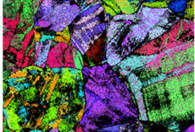The HTME-1000 module is a specialized heating stage developed for high-temperature Electron Backscatter Diffraction (EBSD) analysis at temperatures up to 1000 °C. It can be utilized in any SEM without requiring an Alemnis mechanical testing system.
It is built for vacuum operation and is tuned to limit sample radiative heating at temperatures above 500 °C to guarantee the best possible EBSD analysis.
Get in touch now
Compact, Simple, and Retrofittable
The Alemnis HTME-1000 is the smallest heating stage. Thanks to a straightforward and durable construction, it can be fixed without modification to any SEM stage. All vacuum feedthroughs for electrical connections and cooling water are supported on a single, uniformly sized flange.
Smart Thermal Management
The functioning of the HTME-1000 is safe and dependable, based on significant experience with in situ high-temperature applications. The EBSD-specific thermal shielding and active cooling system are tuned for the finest image quality and detector safety.
In situ EBSD up to 1000 °C
- Best temperature stability of <0.1 °C
- The most cost-effective solution on the market
- Reliable, reproducible, and convenient
- A conservatively specified maximum temperature of 1000 °C
Applications
Microstructural Evolution of a Red Gold (Au-Cu) Alloy

25 °C FCT phase. Image Credit: C. Cayron EPFL, Lausanne

300 °C FCT + FCC phases. Image Credit: C. Cayron EPFL, Lausanne

450 °C FCC phase. IImage Credit: C. Cayron EPFL, Lausanne
Grain Growth of a High Entropy Alloy Thin Film

25 °C Amorphous. Image Credit: S. Kalácska, Empa Thun

750 °C Crystallization onset. Image Credit: S. Kalácska, Empa Thun

1000 °C Recrystallized. Image Credit: S. Kalácska, Empa Thun

Image Credit: Alemnis AG
Simple but efficient: The sample holder is a mechanical clamp with interchangeable thermal shields based on the desired field of view and maximum temperature.
Get in touch now